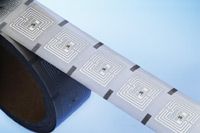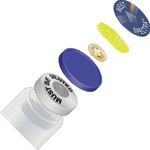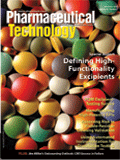Tagging Tools to Provide E-Pedigree
A hybrid system using paper and electronic pedigrees will be needed.
Members of the pharmaceutical supply chain have two choices when it comes to complying with the long-deferred pedigree, or chain of custody, requirements taking effect on Dec. 1, 2006: manual or automated. Although manual data collection and maintenance of paper records for each container's travels from manufacturer to consumer may be feasible, an automated electronic method will provide more timely and accurate data in the long run with minimal expenditure of manpower.
As outlined in 21 CFR 203.50, the seller of a drug product must provide the purchaser with a pedigree "statement identifying each prior sale, purchase, or trade of the drug. The identifying statement must include the proprietary and established name of the drug, its dosage, the container size, the number of containers, lot or control numbers of the drug being distributed, the business name and address of all parties to each prior transaction involving the drug, starting with the manufacturer, and the date of each previous transaction."

Hallie Forcinio
E-pedigree
Electronic pedigree, or e-pedigree, systems rely on automatic identification technology to carry the serialized information that uniquely identifies each bottle or vial. The US Food and Drug Administration favors radio-frequency identification (RFID). The agency's Counterfeit Drug Task Force, however, noted in the June update to its report that bar-code technologies, particularly two-dimensional bar codes, are a viable alternative and that "a hybrid approach using both paper and electronic pedigrees will be needed during a transition period."
An e-pedigree system requires the integration of several technologies, item-level serialization, data capture at various points in the supply chain, and recordkeeping so recipients can trace the product's trip through the supply chain and confirm its authenticity.
Purdue Pharma, L.P. (Stamford, CT) quickly realized item-level tagging had track-and-trace benefits within its four walls when it started tagging containers of its "OxyContin" pain-killer to comply with requirements of Wal-Mart Stores (Bentonville, AR).
Purdue Pharma's system consists of ultrahigh-frequency (UHF) tags and readers, device management software, and data management software (Class 0 UHF tags and readers, Symbol Technologies, Holtsville, NY; device-management software, Northern Apex Software, Fort Wayne, IN; "Auto-ID" and "Event Manager" software from SAP AG, Walldorf, Germany). This system interacts with the company's enterprise resource-planning system ("R/3 ERP," SAP AG) and makes it possible to link each bottle of OxyContin to a specific case and pallet.
Internally, RFID tags are read at three points: at the outfeed of the case packer, vault entry, and vault exit. The reader at the outfeed of the case packer scans each container tag and collects electronic product code (EPC) information along with batch and lot number data, time, and date. This information is linked to the EPC code on the RFID tag on the case. At the entrance to the vault, case tag information is recorded along with time and event data. When the case exits the vault, the case tag is read again. This data is time stamped and linked to a delivery number, thus creating a record of the EPC, batch and lot number, and delivery destination of each bottle. This information not only helps identify containers that deviate from their expected paths, but also helps identify affected containers and expedite retrieval during a recall.

Company Web sites
An e-pedigree trial undertaken with H.D. Smith (Springfield, IL) shipped tagged product and collected and transmitted chain-of-custody documentation using track-and-trace software and collaborative data management ("SupplyScape E-pedigree" software, SupplyScape, Woburn, MA; "ES7000" data management platform, Unisys Corp., Blue Bell, PA).
Since completion of the pilot, H.D. Smith has equipped its distribution center in Pompano Beach, Florida with RFID technology and implemented an e-pedigree system at the same facility ("SupplyScape E-pedigree" software, SupplyScape).
Cardinal Health (Dublin, OH) also is studying e-pedigree technology. Smart labels are converted at the company's printed components facility in Moorestown, New Jersey and shipped to Cardinal's packaging facility in Philadelphia, Pennsylvania. On the packaging line, labels are encoded with item-, case- or pallet-level EPC information. Tagged products are shipped to a Cardinal Health distribution center in Findlay, Ohio, then sent to a healthcare provider that uses the same data collection and transmission technology as the Findlay facility (RFID tags, hardware, software, Alien Technology Corp., Morgan Hills, CA; integration, IBM, Richmond, VA; project management, VerSign, Inc., Mountain View, CA).
Item-level serialization
Item-level serialization begins with a unique code reproduced as a two-dimensional bar code or encoded in an RFID tag. Many drug companies are using both in their item-level tagging and e-pedigree pilots.
The bar code most commonly discussed for item-level tagging is the two-dimensional, checkerboard-like Data Matrix code. Other options are available, however. One translates codes into unique printed marks comprising a series of lines that look a bit like an arrangement of pick-up sticks thrown on a table. These codes can be printed on virtually any surface. They can be virtually invisible or as large as desired. Reading is done by imagers or cameras at speeds of as high as 200 containers per minute, even if the contrast between code and background is low ("2DMI" marks, Orbid Corp., San Francisco, CA).

The "Rafsec Mini" label fits in the small spaces on pharmaceutical containers.
Pharmaceutical manufacturers must decide between high-frequency (13.56 MHz) or UHF tags and have several choices for item-level applications (Item-level RFID tags, ADT Security Services Inc., a unit of Tyco Fire & Security, Boca Raton, FL; Avery Dennison RFID, Westlake Village, CA; Omron RFID, Schaumburg, IL; TAGSYS, Inc., Doylestown, PA; UPM Raflatac, Tampere, Finland).
Purdue Pharma and Cephalon, Inc. (Frazer, PA) have studied UHF tags, while Pfizer (New York, NY) opted to use 13.56-MHz smart labels on bottles of "Viagra" (13.56-MHz tags, TAGSYS, Inc., smart label converter, West Pharmaceutical Services, Lionville, PA).

"West Spectra" vial-closure system incor-porates RFID tags and spectroscopic inks.
Some UHF Gen 2 designs now appearing on the market incorporate new chips. Designed especially for asset tracking and capable of carrying more data than the EPC alone, a chip incorporates 64 bits of user-rewritable memory. Chip memory can be programmed and read repeatedly or can be locked to prevent subsequent alteration ("Monaco/64 Chips," Impinj, Inc., Seattle, WA).
RFID tags for item-level applications typically take the form of smart labels, but sometimes are built into the container itself ("RFID Embedded Packages," Owens-Illinois Healthcare Packaging Inc., Toledo, OH, see "Interphex Focuses on Counterfeit Prevention," Pharmaceutical Technology, June 2006).
An RFID tag is just one of the security features that can be built into vial packaging for parenteral products. A 13.56-MHz tag measuring 9 mm in diameter is incorporated into standard 13- or 20-mm polypropylene seals in a co-injection molding process. Then, tagged seals are inserted into formed aluminum shells and heat staked in place. Each assembled shell is read to verify tag viability before being packed for shipment. The RFID-enabled seals serve as a drop-in replacement for standard seals and can be configured to be read-only; write-once, read-many; or write-many–read-many (9-mm 13.56-MHz tag, TAGSYS; "West Spectra" vial-closure system, West Pharmaceutical Services).

The "FAST Tag" software exchanges information with the host system.
Data capture and storage
Many tag makers also supply readers (smart label readers, Symbol Technologies, TAGSYS, Alien Technology).
Encoding tags and collecting data from tags typically is controlled by specially designed software. The system on the Viagra line, for example, encodes tags, records EPCs, manages rejects, links bar-code and RFID data, and stores information in a database ("TIPS Serialized Product Tracking" vision system and software, SYSTECH International, Cranbury, NJ).
Similar software identifies items to be tagged, sends data to the encoding equipment, triggers tag application, verifies tag readability and code accuracy, and transmits data about tagged items back to the host system. It's typically supplied as part of an optimized turnkey RFID solution that includes assistance with tag selection and placement as well as hardware selection and installation ("FAST Tag" software, Accu-Sort Systems, Inc., Telford, PA).
Collaboration
Establishing e-pedigree systems will require unprecedented collaboration between supply-chain partners because success depends on sharing the data captured at each point in a drug's trip from manufacturer to consumer.
Collaboration will necessitate agreements about who owns the data, where it resides, who has access, and how access occurs. Cooperation also requires some degree of interoperability between systems. In other words, each system must be able to send and receive pedigree data securely in a format it and its supply-chain partners can use.
Like all RFID implementations, embarking on an e-pedigree program using item-level tagging should spur companies to undertake a full needs analysis to define requirements and goals. This process should consider both current and future needs. Once this analysis is complete, pretesting in a laboratory setting helps optimize conditions for the pilot-project phase. Rollout should occur only after rigorous testing during the pilot and then proceed in a phased fashion.
A successful e-pedigree program will involve a considerable amount of effort and expense. Although compliance with pedigree requirements is mandatory, numerous benefits will result in enhanced patient safety, stronger consumer confidence, reduced exposure in recall situations, and, of course, a higher level of supply-chain security that simplifies product authentication, discourages diversion, and minimizes the chance of counterfeit product being dispensed.

Drug Solutions Podcast: A Closer Look at mRNA in Oncology and Vaccines
April 30th 2024In this episode fo the Drug Solutions Podcast, etherna’s vice-president of Technology and Innovation, Stefaan De Koker, discusses the merits and challenges of using mRNA as the foundation for therapeutics in oncology as well as for vaccines.